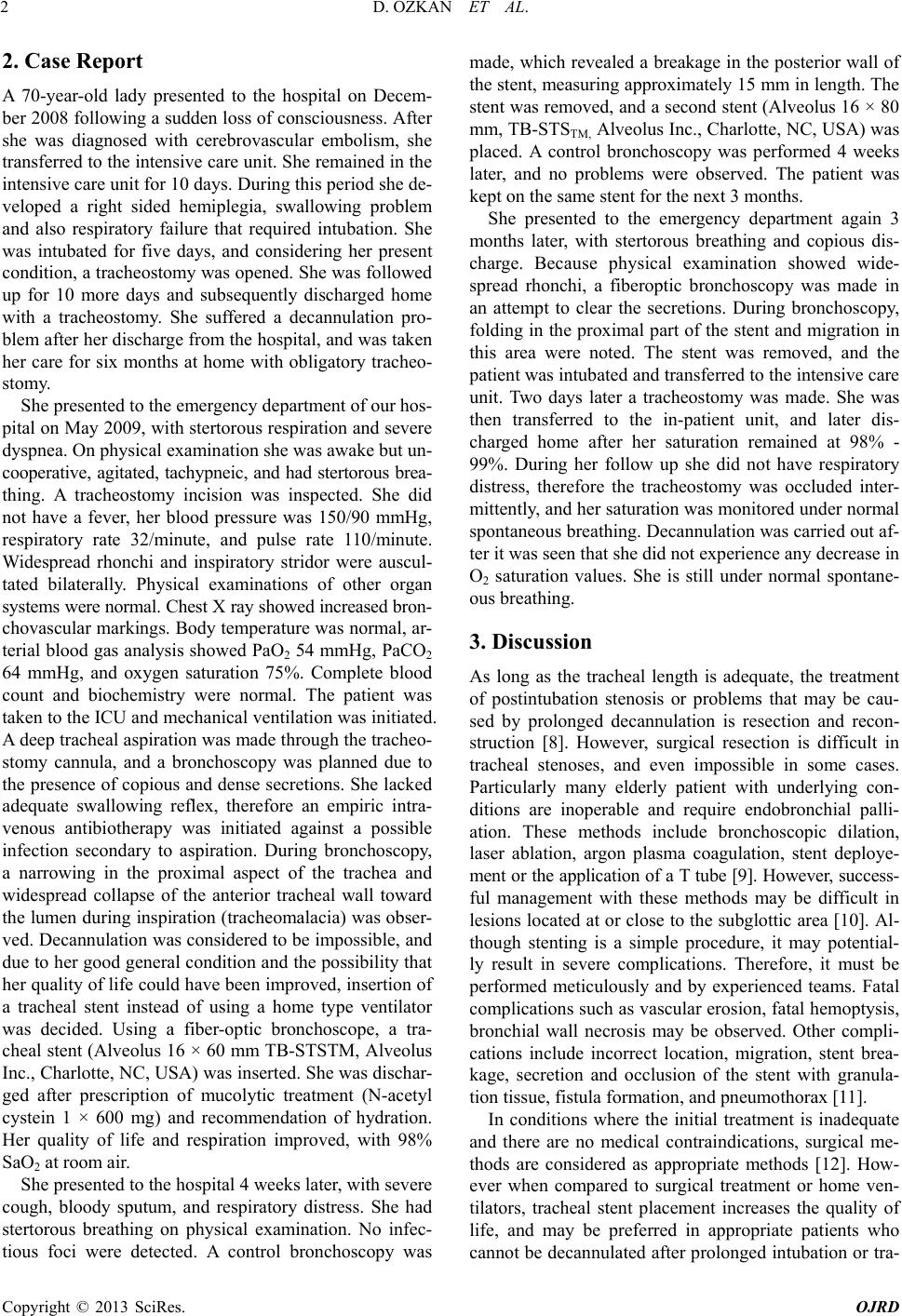
D. OZKAN ET AL.
2
2. Case Report
A 70-year-old lady presented to the hospital on Decem-
ber 2008 following a sudden loss of consciousness. After
she was diagnosed with cerebrovascular embolism, she
transferred to the intensiv e care unit. She remained in the
intensive care unit for 10 days. During this period she de-
veloped a right sided hemiplegia, swallowing problem
and also respiratory failure that required intubation. She
was intubated for five days, and considering her present
condition, a tracheostomy was opened. She was followed
up for 10 more days and subsequently discharged home
with a tracheostomy. She suffered a decannulation pro-
blem after her discharge from the hospital, and was taken
her care for six months at home with obligatory tracheo-
stomy.
She presented to the emergency department of our hos-
pital on May 2009, with stertorous respiratio n and severe
dyspnea. On physical examination she was awake but un-
cooperative, agitated, tachypneic, and had stertorous brea-
thing. A tracheostomy incision was inspected. She did
not have a fever, her blood pressure was 150/90 mmHg,
respiratory rate 32/minute, and pulse rate 110/minute.
Widespread rhonchi and inspiratory stridor were auscul-
tated bilaterally. Physical examinations of other organ
systems were normal. Chest X ray showed increased bron-
chovascular markings. Body temperature was normal, ar-
terial blood gas analysis sh owed PaO2 54 mmHg, PaCO2
64 mmHg, and oxygen saturation 75%. Complete blood
count and biochemistry were normal. The patient was
taken to the ICU and mechanical ventilation was initiated.
A deep tracheal aspiration was made through the tracheo-
stomy cannula, and a bronchoscopy was planned due to
the presence of copious and dense secretions. She lacked
adequate swallowing reflex, therefore an empiric intra-
venous antibiotherapy was initiated against a possible
infection secondary to aspiration. During bronchoscopy,
a narrowing in the proximal aspect of the trachea and
widespread collapse of the anterior tracheal wall toward
the lumen du ring in spira tion (tracheomalacia) was obser-
ved. Decannulation was considered to be impossible, and
due to her good general co ndition and the possibility that
her quality of life could have been improv ed, insertion of
a tracheal stent instead of using a home type ventilator
was decided. Using a fiber-optic bronchoscope, a tra-
cheal stent (Alveolus 16 × 60 mm TB-STSTM, Alveolus
Inc., Charlotte, NC, USA) was inserted. She was dischar-
ged after prescription of mucolytic treatment (N-acetyl
cystein 1 × 600 mg) and recommendation of hydration.
Her quality of life and respiration improved, with 98%
SaO2 at room air.
She presented to the hosp ital 4 weeks later, with severe
cough, bloody sputum, and respiratory distress. She had
stertorous breathing on physical examination. No infec-
tious foci were detected. A control bronchoscopy was
made, which revealed a breakage in the posterior wall of
the stent, measuring approximatel y 15 mm in leng th. The
stent was removed, and a second stent (Alveolus 16 × 80
mm, TB-STSTM, Alveolus Inc., Charlotte, NC, USA) was
placed. A control bronchoscopy was performed 4 weeks
later, and no problems were observed. The patient was
kept on the same stent for the next 3 months.
She presented to the emergency department again 3
months later, with stertorous breathing and copious dis-
charge. Because physical examination showed wide-
spread rhonchi, a fiberoptic bronchoscopy was made in
an attempt to clear the secretions. During bronchoscopy,
folding in the proximal part of the stent and migration in
this area were noted. The stent was removed, and the
patient was intub ated an d transferred to th e inten siv e care
unit. Two days later a tracheostomy was made. She was
then transferred to the in-patient unit, and later dis-
charged home after her saturation remained at 98% -
99%. During her follow up she did not have respiratory
distress, therefore the tracheostomy was occluded inter-
mittently, and her saturation was monitored under normal
spontaneous breathing. Decannulation was carried out af-
ter it was seen that she did not experience any decrease in
O2 saturation values. She is still under normal spontane-
ous breathing.
3. Discussion
As long as the tracheal length is adequate, the treatment
of postintubation stenosis or problems that may be cau-
sed by prolonged decannulation is resection and recon-
struction [8]. However, surgical resection is difficult in
tracheal stenoses, and even impossible in some cases.
Particularly many elderly patient with underlying con-
ditions are inoperable and require endobronchial palli-
ation. These methods include bronchoscopic dilation,
laser ablation, argon plasma coagulation, stent deploye-
ment or the application of a T tube [9]. However, success-
ful management with these methods may be difficult in
lesions located at or close to the subglottic area [10]. Al-
though stenting is a simple procedure, it may potential-
ly result in severe complications. Therefore, it must be
performed meticulously and by experienced teams. Fatal
complications such as vascular erosion, fatal hemoptysis,
bronchial wall necrosis may be observed. Other compli-
cations include incorrect location, migration, stent brea-
kage, secretion and occlusion of the stent with granula-
tion tissue, fistula formation, and pneumothorax [11].
In conditions where the initial treatment is inadequate
and there are no medical contraindications, surgical me-
thods are considered as appropriate methods [12]. How-
ever when compared to surgical treatment or home ven-
tilators, tracheal stent placement increases the quality of
life, and may be preferred in appropriate patients who
cannot be decannulated after prolonged intubation or tra-
Copyright © 2013 SciRes. OJRD